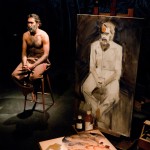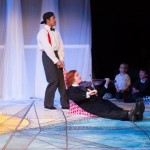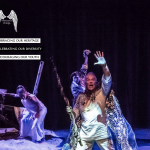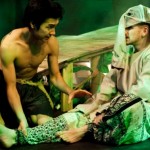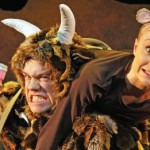Of Mice And Men
Genre: Drama
Venue: The Brockley Jack Studio Theatre 410 Brockley Road Brockley London SE4 2DH
Low Down
On seeing students at the matinee performance I attended of the Jack Studio Theatre’s Of Mice And Men, I reflected on Steinbeck’s text in classrooms all around the world: each encounter with the story of George and Lennie provoking young minds to consider the harsh truths about our human vulnerability: Lennie with his ‘slow’ brain; Candy with his amputated hand; and Crooks with his broken back symbols of a deeper and more pernicious malaise. The extraordinary events of the Great Depression ironically giving rise to desperate dreams for a better life. As the audience come into the theatre, they encounter the world of 1930s rural California and those bad times: wonderfully evoked through broken wooden fences and a hessian sandbagged river embankment, the elegant simplicity of Linden’s realization of the play before them.
Review
The Jack’s production of Of Mice and Men held many refreshing surprises. The first was the effect of the pre-set on the audience entering the theatre: hues of the rustic, broken landscape seem to evoke reverence, as the practical need to be that little bit more cautious in finding a seat in dimmed light set the tone to carefully pay attention to the performance space as well. Jess Bennett’s set design expressionistically formed another country before us, like a world poised just above our everyday experience: held stretched out between the sky and the earth in sepia tones and soft greys.
The struggle to dream for something better is ever dignified in the play’s presentation of impossible relationships: firstly in George’s and Lennie’s friendship as George takes ‘care’ of Lennie and Lennie tries to be ‘just right’ for George. Their struggle to remain together sets the tone for the drama, and is exploited through Curly’s relationship to his restless, unsatisfied wife; Crook’s ‘the nigger’ relationship to the white workers; right down to old Candy’s relationship with his stinking, disease-ridden dog.
The style of performance from the ensemble of nine actors is physically beautiful to observe: it seems almost choreographed rather than ‘blocked’ in the space. Adam Diggle’s Lennie, for instance, moves from tall, upright and bouncing to falling about on the ground. By contrast, Tarl Capple’s George darts vigilantly here and there, squatting onto his knees, thinking what to do next for both himself and Lennie. It did cross my mind if perhaps assistant director, Hugo Carosa’s training with Phillippe Genty and other non-naturalistic practitioners might have been harnessed by director Linden: to augment the play’s vision of internal struggles as well as physical hardship. The attention to physical detail on the actors’ bodies was marvelous: Candy’s missing hand; Crook’s broken back; Lennie’s holding of the mouse and puppy; and Slim’s cleaning of leather.
Ultimately, the sense of choreographed movement seems to bring together the two intersecting lines of tragedy in the play: the one poised around Lennie’s extraordinary physical strength and the other precipitated by the desires of Curly’s wife for intercourse – for a conversation, a touch and, dangerously, more. As George and Lennie are travelling towards their dream homestead, Curly’s wife is on her way to Hollywood to fulfill her dreams for a better life: better, that is, than the one bequeathed by her mother which has lead her to marriage and life with Curly.
The mouse, the puppy and the wife-with-no-name are held in Lennie’s grasp and all are killed. As both a victim and violent agent himself, the ‘mentally retarded’ Lennie highlights the indiscriminate nature of social and economic destruction presented in the world of the play. The clarity of direction ensures that the audience doesn’t miss any detail of how the tragedy is unfolding moment for moment. The transition from scene to scene is a transformative experience: the actors’ singing of American spiritual and folk songs like ‘Shall We Gather At The River’ ensures that practical need is folded back into the play’s symbolic unfolding. Again, the physical setting performs an expressionistic role as the river embankment is rearranged into the bunk-house, then Crook’s room with the animals in the stable only to return again to the river’s edge.
I was genuinely sorry not to have viewed this production until the end of its run. I recommend that if serious theatre audiences have not discovered The Jack Studio Theatre in South London yet that they must do so and support Tanith Linden’s extraordinary talent: cast, crew and producers of the Jack exemplify how great theatre is created on ‘the fringe’.
Reviewed by Josey De Rossi Wednesday 21st September, 2011
Website :
http://www.brockleyjack.co.uk/index.html
